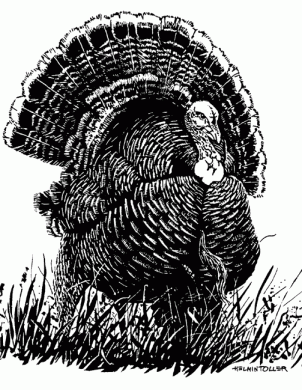Blog - General
Happy Thanksgiving
Fun Turkey Facts
- Mature turkeys have 3,500 or so feathers. The Apache Indians considered the turkey timid and wouldn’t eat it or use its feathers on their arrows.
- Turkeys originated in North and Central America, and evidence indicates that they have been around for over 10 million years.
- In Mexico, the turkey was considered a sacrificial bird.
- Only male turkeys (toms) gobble. Females (hens) make a clicking noise. The gobble is a seasonal call during the spring and fall. Hens are attracted for mating when a tom gobbles. Wild toms love to gobble when they hear loud sounds or settle in for the night.
- During the day turkeys forage for acorns, seeds, insects and berries.
- Wild turkeys have excellent vision during the day but not at night.
- Juvenile turkeys are called “jakes”.
- Wild turkeys make short flights. Domestic turkeys cannot fly.
The Turkey! Our National Bird? In 1784, after the end of the Revolutionary War, Benjamin Franklin wrote a famous letter from Paris to his daughter, criticizing the choice and suggesting the Wild Turkey as a better representative of American qualities. He described the Bald Eagle as “a Bird of bad moral character,” who, “too lazy to fish for himself” survived by robbing the Osprey of its catch. He also called the Bald Eagle “a rank Coward” who was easily driven from a perch by the much smaller kingbird. In the letter, Franklin wrote that he favored the Turkey, “a much more respectable Bird,” which he described as “a little vain & silly but a Bird of Courage.” Despite Franklin’s objections, the Bald Eagle remained the emblem of the United States. It can be found on both national seals and on the back of several coins (including the quarter dollar coin until 1999), with its head oriented towards the olive branch. Between 1916 and 1945, the Presidential Flag showed an eagle facing to its left (the viewer’s right), which gave rise to the urban legend that the seal is changed to have the eagle face towards the olive branch in peace, and towards the arrows in wartime.
Turkey Populations at Record Numbers:In the early 1930s, wild turkeys were on the verge of extinction nationwide due to over harvesting and habitat degradation. Originally the Eastern Turkey was native to Nebraska but was extirpated by 1915. It has since be replaced by the Merriam Turkey from a captive breeding program which began in Nebraska in 1959. Habitat improvement and successive dry years have led to an increase in Nebraska’s turkey population statewide in recent years. Many customers living near wooded areas with open grass and mixed vegetation report turkeys foraging under their bird feeders.
